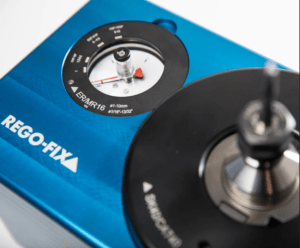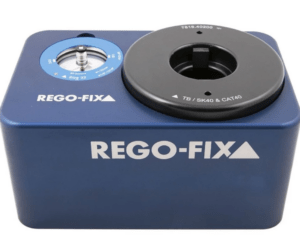
For years, collet-type toolholder assembly and setup have relied on cumbersome, error-prone manual methods that waste time and money. From a wall filled with adjustment charts, operators reference torque values based on specific collet series holders and tool diameters. Then they must locate the appropriate torque wrench, unlock it, set its torque level and re-lock it before tightening a toolholder’s collet retention nut. This complex procedure leaves many shops scrambling to regain precious lost production time – and often leads to inaccurate torque settings that can damage toolholders and, in some instances, affect workpiece precision negatively .
With increasing demands for tighter tolerances in industries – aerospace and medical manufacturing, for example – where even slight deviations from specifications can cause traumatic results, shops need a foolproof way to ensure that all their collet toolholders are set consistently at the correct torque levels. That foolproof solution is a recently introduced system that not only takes the guesswork out of determining proper torque levels, but also makes toolholder setup fast, easy and consistent.
Seeing the damaging consequences of over-torqued tools, including its own ER collets and nuts, toolholder OEM REGO-FIX developed the TORCO-BLOCK system, which requires neither charts nor torque wrenches. The TORCO-BLOCK relies on new technology that enables one gauge to cover virtually an entire collet series. This straightforward device measures the applied torque quickly and accurately, replacing a large collection of reference tables and specialized adjustable wrenches with a single compact system that operators of all skill and experience levels can use successfully.

The old-fashioned alternative led shops into sloppy habits intended to save time and simplify the setup process. Under deadline pressure or unsure of exactly what to do, many shops locked their torque wrenches at maximum values and left them there, trying to cut corners with what looked like a quick solution. Not all nuts transfer the same amount of clamping force to the collet, however, and some transfer it more efficiently than others. As shops attempted to apply the same approach to every setup, they over-tightened their tools with improperly adjusted torque wrenches, transmitting undue force into the thinnest, most-vulnerable parts of toolholders. That force damaged toolholders, collets and nuts – and introduced runout that led to improper tolerances and rejected workpieces. Conversely, backing off and applying too little torque left tools dangerously loose enough to pull out of toolholders.
Some solutions to these setup problems substitute new complexities for old ones, adding bulky hardware or complex, expensive digital technologies that change the setup process but may not improve it. The TORCO-BLOCK is an analog device that attaches to a workbench with six bolts in a 6.693″ x 10.629″ (170 x 270 mm) footprint, and includes a set of 10 color-coded indicator rings, each displaying the shank diameters for a specific type of collet. An operator places the appropriate ring on top of the unit, sets a single indicator to the appropriate shank diameter and uses a standard wrench to tighten the toolholder until an indicator needle lines up with the target size. A hydraulic system inside the unit measures torque and displays it on the pressure gauge on top of the unit. When the indicator needle lines up with the torque value, the operator knows that the adjustment is correct and complete.
Simplicity and flexibility make a torque-assist system easy to use for a wide range of common toolholders, provided that the manufacturer sets up the system to handle the full range of production hardware. Along with REGO-FIX ER collets, the TORCO-BLOCK system also handles other brands with compatible torque ratings. The TORCO-BLOCK’s set of adapters accommodates all standard spindle interfaces, including CAT, SK, BT, HSK and REGO-FIX CAPTO options. Each adapter inserts into the top of the TORCO-BLOCK unit and turns until it clicks into place. Recessed screws tighten with a standard Allen key and hold the adapters in place.
When shops consistently apply the correct torque when assembling collet-type toolholders, they achieve proper tool performance, long tool life and precision-machined parts. Assembly-assist systems such as the TORCO-BLOCK give shops peace of mind, knowing that all their operators can and will comply with tool setup specifications.